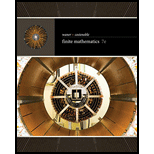
In Exercises 25–32, set up the payoff matrix.
Marketing Your fast-food outlet, Burger Queen, has obtained a license to open branches in three closely situated South African cities: Brakpan, Nigel, and Springs. Your market surveys show that Brakpan and Nigel each provide a potential market of 2,000 burgers a day, while Springs provides a potential market of 1,000 burgers per day. Your company can finance an outlet in only one of those cities. Your main competitor, Burger Princess, has also obtained licenses for these cities and is similarly planning to open only one outlet. If you both happen to locate at the same city, you will share the total business from all three cities equally, but if you locate in different cities, you will each get all the business in the city in which you have located plus half the business in the third city. The payoff is the number of burgers you will sell per day minus the number of burgers your competitor will sell per day.
Want to see the full answer?
Check out a sample textbook solution
Chapter 4 Solutions
Finite Mathematics
- A retail store manager claims that the average daily sales of the store are $1,500. You aim to test whether the actual average daily sales differ significantly from this claimed value. You can provide your answer by inserting a text box and the answer must include: Null hypothesis, Alternative hypothesis, Show answer (output table/summary table), and Conclusion based on the P value. Showing the calculation is a must. If calculation is missing,so please provide a step by step on the answers Numerical answers in the yellow cellsarrow_forward. The students who attend Memorial High School have a wide variety of extra-curricular activities to choose from in the after-school program. Students are 38% likely to join the dance team; 18% likely to participate in the school play; 42% likely to join the yearbook club; and 64% likely to join the marching band. Many students choose to participate in multiple activities. Students have equal probabilities of being freshmen, sophomores, juniors, or seniors.What is the probability of the union of being either a freshman or senior? 0.07 0.44 0.50 0.25arrow_forwardExplain the conditions under which the Radius of Convergence of the Power Series is a "finite positive real number" r>0arrow_forward
- No chatgpt pls will upvotearrow_forwardQ/By using Hart man theorem study the Stability of the critical points and draw the phase portrait of the system:- X = -4x+2xy - 8 y° = 4y² X2arrow_forwardThis means that when the Radius of Convergence of the Power Series is a "finite positive real number" r>0, then every point x of the Power Series on (-r, r) will absolutely converge (x ∈ (-r, r)). Moreover, every point x on the Power Series (-∞, -r)U(r, +∞) will diverge (|x| >r). Please explain it.arrow_forward
- Q1: A slider in a machine moves along a fixed straight rod. Its distance x cm along the rod is given below for various values of the time. Find the velocity and acceleration of the slider when t = 0.3 seconds. t(seconds) x(cm) 0 0.1 0.2 0.3 0.4 0.5 0.6 30.13 31.62 32.87 33.64 33.95 33.81 33.24 Q2: Using the Runge-Kutta method of fourth order, solve for y atr = 1.2, From dy_2xy +et = dx x²+xc* Take h=0.2. given x = 1, y = 0 Q3:Approximate the solution of the following equation using finite difference method. ly -(1-y= y = x), y(1) = 2 and y(3) = −1 On the interval (1≤x≤3).(taking h=0.5).arrow_forwardФ sketch stability x= -4x + 2xy - 8 y° = 4 y 2 - x² чуг.arrow_forward2 Q/Given H (x,y) = x² + y² - y² Find the Hamiltonian System and prove it is first integral-arrow_forward
 Discrete Mathematics and Its Applications ( 8th I...MathISBN:9781259676512Author:Kenneth H RosenPublisher:McGraw-Hill Education
Discrete Mathematics and Its Applications ( 8th I...MathISBN:9781259676512Author:Kenneth H RosenPublisher:McGraw-Hill Education Mathematics for Elementary Teachers with Activiti...MathISBN:9780134392790Author:Beckmann, SybillaPublisher:PEARSON
Mathematics for Elementary Teachers with Activiti...MathISBN:9780134392790Author:Beckmann, SybillaPublisher:PEARSON
 Thinking Mathematically (7th Edition)MathISBN:9780134683713Author:Robert F. BlitzerPublisher:PEARSON
Thinking Mathematically (7th Edition)MathISBN:9780134683713Author:Robert F. BlitzerPublisher:PEARSON Discrete Mathematics With ApplicationsMathISBN:9781337694193Author:EPP, Susanna S.Publisher:Cengage Learning,
Discrete Mathematics With ApplicationsMathISBN:9781337694193Author:EPP, Susanna S.Publisher:Cengage Learning, Pathways To Math Literacy (looseleaf)MathISBN:9781259985607Author:David Sobecki Professor, Brian A. MercerPublisher:McGraw-Hill Education
Pathways To Math Literacy (looseleaf)MathISBN:9781259985607Author:David Sobecki Professor, Brian A. MercerPublisher:McGraw-Hill Education





